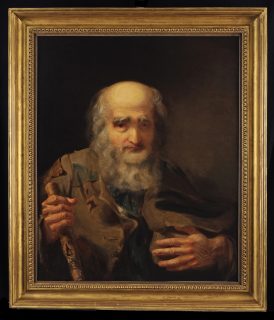 Most portraits of soldiers who fought for American independence depict elegant, attractive men in the prime of life. This oil-on-canvas portrait of a veteran of the Revolutionary War is something different—a somber and arresting view of a poor man that hints at the financial struggles many soldiers of the Revolution faced in old age. John Neagle (1796-1865) painted A Pensioner of the Revolution in 1830, in the midst of the fight for federal pension benefits for the remaining Revolutionary War veterans. It is the earliest-known portrait of a homeless American veteran.
Most portraits of soldiers who fought for American independence depict elegant, attractive men in the prime of life. This oil-on-canvas portrait of a veteran of the Revolutionary War is something different—a somber and arresting view of a poor man that hints at the financial struggles many soldiers of the Revolution faced in old age. John Neagle (1796-1865) painted A Pensioner of the Revolution in 1830, in the midst of the fight for federal pension benefits for the remaining Revolutionary War veterans. It is the earliest-known portrait of a homeless American veteran.
Neagle stated that the subject of the Pensioner was Joseph Winter, who was living on the street in Philadelphia when the artist met him in December 1829. “I found him much benumbed with cold and scantily clad—His outer dress was ragged—His flannel and coat scarcely covered his naked body and he had an apology for a shirt—all were in rags and strings,” Neagle wrote in his diary (collection of the Historical Society of Pennsylvania). Winter, a German-born veteran of the Revolution, earned a living after the war as a weaver in Bethlehem, Pennsylvania, but with approaching old age he had lost his livelihood and family—“a lone wanderer in a world evincing but little feeling or sympathy for him,” Neagle said. Moved by Winter’s situation, the artist brought him to his house, tended to his needs and listened to his story—through the translations of his German-speaking grocer, as Winter apparently did not speak English well. Neagle, having decided that Winter was “a Noble Subject for the pencil,” painted his portrait before seeing him off, bound for Lancaster where he hoped to find some of his countrymen and friends.
Neagle painted two versions of the portrait, which he initially titled the Mendicant. The version the Institute acquired in April 2017 was first owned by Dr. William Potts Dewees (1768-1841), a Neagle family physician and subject of one of the artist’s most celebrated portraits. The painting attracted popular attention in early 1831, when John Sartain (1808-1897) issued a fine mezzotint engraving of the work under the title Patriotism and Age. With the sitter now identified as a participant in the War for Independence, Americans viewed the work with both sympathy and outrage, as Congress continued to debate providing pensions to Revolutionary War veterans. “This picture speaks a satire of melancholy truth,” on viewer commented, “that must reach the heart of every American, who is not forgetful of the blessings inherited from his forefathers. It is a burning shame that beggary and scoffing are the lot of those aged benefactors of their country.” This haunting portrait was a call to the conscience of the nation to care for those who had fought its battles and won its freedom, and a startling reminder that a veteran of America’s celebrated War for Independence could return home to become a poor or even homeless man . Federal pension legislation was enacted in 1832, but it is unknown if Joseph Winter survived to benefit from it.
See more information about this portrait in the Institute’s online museum collections database.
View More Paintings